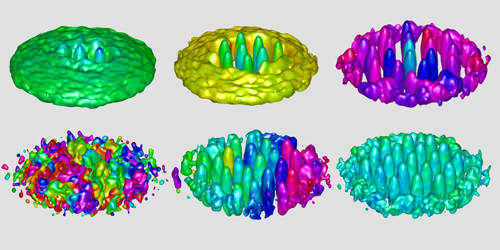A Supersolid Disk
Last year, using ultracold dysprosium atoms, researchers created the first 2D supersolid—a weird quantum material that has the ordered structure of a solid but that can flow like a frictionless fluid. That 2D supersolid resembled a long, thin rhomboid, leaving open the question of whether 2D supersolids could be molded into other geometries. Now, Thomas Bland of the Austrian Academy of Sciences and colleagues give a positive answer to this question by theoretically and experimentally demonstrating a disk-shaped supersolid [1]. The team, which includes members of the group behind the earlier demonstration, says that such a 2D supersolid could be used to study quantum vortices, a key feature of supersolids’ superfluid behavior.
To make a supersolid, researchers usually first turn a collection of atoms into a superfluid and then add a crystalline structure by altering the interactions between the atoms. This route works well in 1D but fails in 2D, as the crystallization step destroys the superfluidity. The material is “much less super,” Bland says. Because of that, Bland and his colleagues needed to search for an alternative method to form a 2D supersolid.
The team instead decided to simultaneously induce superfluidity and crystallization in their system. To do that, they turned to evaporative cooling, which lowers an atomic system’s energy by allowing the hottest atoms to leave. This method has been used to cool atoms to ultracold temperatures for nearly three decades, but it wasn’t known if it would work for making a 2D supersolid. The team developed a theory to simulate how supersolids might form from evaporative cooling and then put that theory into action, showing that it is a viable method for creating stable 2D supersolids.
–Katherine Wright
Katherine Wright is the Deputy Editor of Physics Magazine.
References
- T. Bland et al., “Two-dimensional supersolid formation in dipolar condensates,” Phys. Rev. Lett. 128, 195302 (2022).




